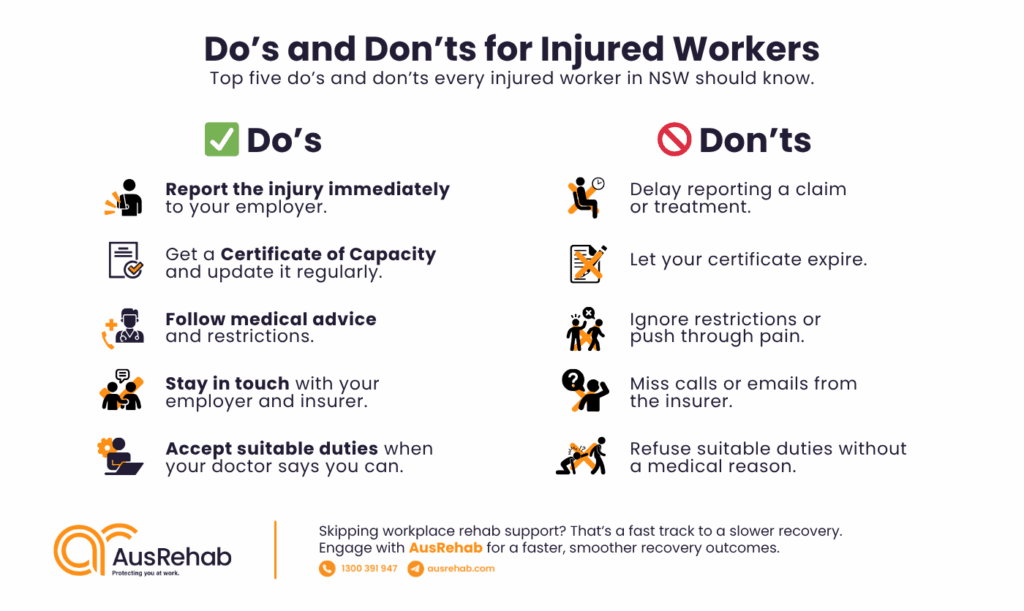• 13 min read
The Do’s and Don’ts of Workers' Compensation: Common Mistakes to Avoid
-
By Suzzy at AusRehab

Prefer to Listen? Play this 5-minute quick summary instead!
Mistakes in a workers’ compensation claim can turn a simple workplace injury into a long, stressful process. A missed form, a late report, or an ignored phone call may delay payments or even result in a claim denial. In NSW, compliance and communication are not optional. They determine how quickly and successfully a worker can recover and return to work.
At AusRehab, we have seen how small errors can cause significant setbacks. Our team supports injured workers, employers, and insurers throughout the workers’ comp NSW process. We help ensure the right steps are followed, the right documentation is filed, and all parties remain connected. This practical guide highlights common workers’ comp errors that often lead to delays or disputes, and how to avoid them.
Do’s and Don’ts for Injured Workers
Recovering from an injury can be stressful, but following the right steps keeps your workers’ compensation claim on track and helps you return to work safely. Here are the top five do’s and don’ts every injured worker in NSW should know.

Why the Do’s and Don’ts of Workers’ Comp Matter
Understanding the do’s and don’ts of workers’ compensation can make a real difference in how smoothly your claim progresses. In NSW, the process is time-sensitive and relies on clear communication between you, your employer, your doctor, and your insurer.
When an injury is reported promptly, it allows the insurer to assess the situation early and provide provisional payments faster. This not only helps you stay financially stable but also reduces the risk of disputes and unnecessary investigations.
What should you not do while on workers’ compensation?
Avoid missing reports, ignoring insurer requests, or exaggerating symptoms. Keep your Certificate of Capacity current, stay in touch with your employer, and follow medical advice. Practising consistent workers’ compensation communication tips ensures your claim runs smoothly and your recovery remains on track.
Common Mistakes That Delay or Jeopardise a Claim
Small oversights often cause major problems. Awareness of the common mistakes in workers’ compensation claims helps everyone involved prevent avoidable setbacks. Here is a quick map of what often goes wrong and how to fix it.
Mistake | Possible Impact | How to Fix It |
Late injury reporting. | Insurer investigations and payment delay. | Tell your employer as soon as possible. The employer then notifies the insurer within 48 hours. |
Missing Certificate of Capacity. | Weekly payments paused. | Provide a current certificate. Renew about every 28 days unless there is a valid reason to extend. |
Ignoring insurer emails or calls. | Claim stalls. | Respond within the requested timeframes. Ask your rehab provider to help if you are unsure. |
Inconsistent details between the doctor and the employer. | Credibility concerns and possible IME referral. | Keep your accounts consistent. Bring your duty list to GP visits. Ask for a case conference if there is confusion. |
Refusing suitable duties without medical grounds. | Benefits are affected, and trust erodes. | Request a workplace assessment to match tasks to your current capacity. |
Delays in communication or inconsistent paperwork often lead insurers to request Independent Medical Examinations (IME), extending claim time. Quick updates and clear records reduce the need for extra reviews.
What happens if I delay reporting my work injury?
Delays can trigger additional investigations and postpone payments. In NSW, it is best practice to notify your employer immediately and file the claim within a few days of injury. The insurer then contacts you within three business days and considers provisional weekly payments within seven days unless there is a reasonable excuse.
Can I refuse suitable duties while on workers' compensation?
In NSW, refusing suitable duties without a valid medical reason can affect ongoing benefits. Workers have the right to perform duties consistent with their medical capacity, but outright refusal may lead to claim suspension.
Do’s and Don’ts for Employers
Employers shape outcomes more than any policy document. Consistent contact, timely insurer notification, and practical duties reduce costs and disputes. Here is a simple playbook for employer obligations for workers’ compensation in NSW.
Employer Do’s
✅ Notify the insurer within 48 hours once you know about the injury. This triggers insurer contact and helps with provisional decisions.
✅ Offer suitable duties that respect restrictions. Adjust hours, tasks, and tools so work remains safe and meaningful.
✅ Keep a clear record of calls, emails, and meetings. This helps if questions arise later.
✅ Schedule short, regular check-ins with the worker. Focus on progress, barriers, and next steps.
✅ Use a written return-to-work planning NSW document that names tasks, hours, review dates, and responsibilities.
Employer Don'ts
🚫 Do not push tasks that exceed restrictions. That increases risk and can breach obligations.
🚫 Do not leave the insurer to manage the relationship alone. Your regular contact builds trust and speeds decisions.
🚫 Do not let a plan go stale. Review it whenever the Certificate of Capacity changes.
A supportive workplace improves morale and decreases overall claim costs. Workers feel respected, and disputes become less likely.
What should employers do when an employee is injured at work?
Ensure the worker receives first aid and medical attention. Report the injury to your insurer within 48 hours. Provide suitable duties and maintain regular communication with the worker and rehabilitation provider.
What are the don’ts for employers in workers' compensation?
In managing workplace injury in NSW, employers should avoid assigning unsuitable work, delaying contact with the injured worker, or neglecting to provide updates to the insurer. A proactive, transparent approach leads to better outcomes for everyone involved.
How Communication Shapes Workers' Comp Outcomes
Clear communication defines how smoothly a workers’ compensation claim in NSW progresses. Confusion between stakeholders often leads to frustration and missed deadlines.
Communication failures can lead to duplicate information, delayed payments, or inconsistent instructions. Open dialogue among the worker, employer, doctor, insurer, and rehab provider ensures consistency and cooperation.
AusRehab coordinates communication loops, ensuring every party receives the same updates. When everyone hears the same plan, things move faster. This clarity also supports an insurer’s duty to act on provisional payments promptly where appropriate. We host Medical Case Conferences that allow all stakeholders to discuss treatment progress and confirm next steps.
💡 Pro Tip: Regular five-minute check-ins between worker and employer can reduce claim duration by up to 25 % (WorkSafe QLD). Discuss practical questions like what went well, what was hard, and what needs adjusting before the next shift. Short updates often remove small barriers before they become big ones.
How can communication affect a workers' compensation claim?
Accurate, timely updates help the insurer decide quickly and reduce the need for external assessments. If information is inconsistent or late, more reviews are likely, which delays decisions. AusRehab’s role is to keep each party informed and to align tasks with medical capacity using objective assessments like Functional Capacity Evaluations.
Legal and Compliance Considerations
The WorkCover NSW scheme sets strict rules for reporting, documentation, and return-to-work procedures. Understanding these requirements keeps claims compliant. Below are the critical workers’ compensation time limits and obligations to know:
- Notify the employer as soon as possible after an injury. The employer must notify the insurer within 48 hours of becoming aware of it.
- Claim lodgement. A claim should be lodged within 6 months of injury or awareness. Extensions can apply in defined situations, including later discovery or serious impairment.
- Insurer contact. The insurer will contact the worker within 3 business days after notification.
- Provisional weekly payments. The insurer should start these within 7 days of notification unless a reasonable excuse applies.
- Certificates of Capacity. Generally valid for up to 28 days unless clinically justified for longer. Keep them current to maintain entitlements and guide duties.
- Employer suitable duties. Employers are expected to provide work that matches capacity where practicable. That can include similar tasks, adjusted hours, or reassignment.
What are the legal time limits for lodging a workers' comp claim in NSW?
In most cases, you have 6 months to lodge a workers’ compensation claim from the date of injury or from when you became aware of it. There are limited exceptions where the window may extend. Do not wait. Early action supports faster decisions.
How Mistakes Lead to Claim Denials or Delays
Simple administrative issues can quickly escalate into claim denials or workers’ comp disputes. Here are patterns that tend to trigger escalations and how workplace rehabilitation can interrupt them.
- Expired or missing Certificate of Capacity. Weekly payments may pause, and treatment approvals lag. Book your GP before expiry. Share the update with the employer and insurer the same day.
- Mixed messages about capacity. If duties, GP notes, and worker reports do not align, insurers may seek an Independent Medical Examination (IME). A Medical Case Conference with the GP, worker, employer, and AusRehab aligns expectations and usually prevents further delay.
- Refusing suitable duties. This can affect weekly benefits and trust. Ask for a Workplace Assessment to match tasks to restrictions and to document why a task is not appropriate if that is the case.
- Silence or slow responses. Missed emails equal missed approvals. Set calendar reminders for insurer due dates. Ask your rehab provider to help you reply with the right details.
- Late claim lodgement. The six-month limit is generous, but waiting creates avoidable questions. Early lodgement helps provisional decisions and reduces financial stress.
Early engagement with rehabilitation providers like AusRehab provides objective reports and proactive coordination. This ensures the insurer receives verified medical and vocational information early, preventing unnecessary IME referrals.
Can workers' compensation be denied due to mistakes?
Yes, a claim can be denied when significant errors occur. Late reporting, incomplete medical evidence, or inconsistent accounts of the injury can lead insurers to question liability. These workers’ comp errors may cause delays, additional investigations, or rejection of benefits.
To avoid the consequences of such mistakes, ensure that claims are reported promptly, all certificates are current, and communication remains consistent between the worker, employer, and insurer.
AusRehab’s Role and Expertise
AusRehab is a trusted workplace rehab provider in NSW that serves as a bridge connecting injured workers, employers, insurers, and treating practitioners.
What AusRehab does for all parties
- Workplace Assessment: We review tasks, tools, and environment, then map an individual duties plan aligned with medical restrictions. This is the fastest route to safe productivity.
- Functional Capacity Evaluation: We provide objective measurements of a worker’s physical or psychological capacity so the plan reflects true ability. This reduces disputes by replacing guesswork with data.
- Vocational Assessment: If the pre-injury role is no longer viable, we identify realistic job options and labour-market matches across NSW. This helps with transitions to a new employer where needed.
- Medical Case Conference: We bring the GP, insurer, worker, and employer together to agree on a clear path, dates, and responsibilities.
- Return-to-Work Planning: We document tasks, hours, restrictions, and review dates so everyone knows what happens next.
This structured approach ensures return-to-work plans are medically safe, cost-effective, and compliant with NSW guidelines.
Case Snapshot: Early Intervention Success
A construction worker sustained a back injury while lifting heavy materials. AusRehab engaged within one week of the claim. Through an early Workplace Assessment and Suitable Duties Plan, the worker returned to part-time duties within four weeks. The claim closed 30% faster than similar cases where rehabilitation was delayed.
This example demonstrates how early communication, accurate assessment, and stakeholder collaboration shorten claim duration and reduce costs.
How can a workplace rehabilitation provider help avoid claim delays or disputes?
By providing independent, objective assessments that clarify a worker’s abilities, rehab providers reduce confusion between doctors, insurers, and employers. Their evidence supports clear decisions and quicker approvals.
Return to Work Confidently with AusRehab
Every workers’ compensation claim in NSW depends on prompt reporting, clear communication, and cooperation between all parties. Most common mistakes in workers’ compensation claims can be avoided by staying proactive and informed.
For injured workers, it means reporting quickly and following medical advice. For employers, it means offering genuine support and maintaining open dialogue. For everyone involved, early engagement with a workplace rehab provider in NSW makes all the difference.
AusRehab helps ensure claims stay compliant, evidence-based, and focused on safe recovery. Partner with us for a smooth, compliant recovery process.
📞 Contact us today to book a free workplace rehabilitation consultation or discuss your return-to-work planning needs.
Frequently Asked Questions (FAQs)
What are the most common mistakes in workers' compensation claims?
The common mistakes in workers’ compensation often involve late reporting, missing or expired Certificates of Capacity, and inconsistent information between the worker, employer, and doctor. Other frequent workers’ comp errors include ignoring insurer emails, delaying medical treatment, or refusing to participate in return-to-work planning.
Understanding the basic workers’ comp dos and don’ts helps avoid these issues. Report the injury early, stay in contact with all parties, and keep documents up to date to prevent delays or disputes.
What is AusRehab’s role in managing workers’ compensation claims?
AusRehab provides coordinated workplace rehabilitation services that guide injured workers, employers, and insurers through the workers’ compensation process. We deliver structured workers comp support through communication, assessments, and return-to-work planning.
Our team ensures recovery is safe, compliant, and efficient. When needed, we also provide vocational rehabilitation in NSW to help workers transition to suitable employment.
How does AusRehab support employers and insurers during workers' comp claims?
AusRehab plays a key coordination role through structured workplace rehab planning in NSW. We provide independent assessments, liaise with medical practitioners, and keep all parties informed through case conferences and regular updates.
Our RTW coordination ensures that each plan aligns with medical restrictions and workplace needs. By maintaining clear insurer collaboration in NSW, we help employers meet their obligations, support injured workers, and reduce the duration and cost of claims.
What assessments does AusRehab provide under workers' compensation?
AusRehab provides a range of assessments to support safe and efficient recovery under workers’ compensation. These include Workplace Assessments, Functional Capacity Evaluations, Vocational Assessments, Medical Case Conferences, and Suitable Duties Planning. Each assessment delivers clear, objective information to guide treatment, support return-to-work goals, and ensure compliance with NSW requirements.
How can employers and workers reduce disputes in workers' comp claims?
Reducing disputes in workers’ comp in NSW starts with open communication, early action, and cooperation. When all parties share information promptly and accurately, issues are resolved before they escalate.
Engaging in early rehab intervention with providers like AusRehab also helps by providing clear assessments and coordinated plans that remove uncertainty and support faster resolution.
Don’t forget to share!
Subscribe to stay updated on the latest workplace news.

Resolve your work
place injury today
